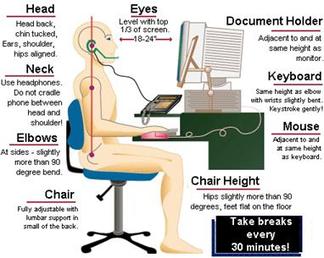Improving your Office Ergonomics
2/4/2016
By: Sonia Gashgarian, MscPT  Adults spend approximately 9.5 hours (or 69% of all waking hours) sitting each day according to Statistics Canada. Partly to blame is the fact that most job positions involve a lot of sitting – whether you are sitting in a meeting, sitting at your desk, or sitting during your commute to work. While leading a sedentary lifestyle can increase the risk of disease and health complications, too much sitting can also lead to musculoskeletal injuries. There are 3 factors that can increase the risk of injury; a combination of these factors increases injury risk even more: 1. Force 2. Repetition 3. Awkward Posture Considering the fact that a lot of office workers sit hunched forward in their office chair (an awkward posture) while working on the computer (a repetitive task), it is no wonder many people develop low back pain, neck and shoulder injuries, carpal tunnel syndrome, etc. However, there are several quick, simple, and easy changes that can be made to your desk set-up and sitting habits that will help to prevent the above mentioned injuries: 1. Adjusting the Chair. The image below outlines a better sitting alternative to sitting hunched forward. Here are some general guidelines: a. Sit right back in the chair and avoid leaning forward b. Tilt the seat pan forward so that the thighs are parallel to the floor or angled slightly downward c. Rest your feet fully on the floor, or use a foot rest if unable to reach the floor d. Recline the back rest to tilt back 100-110° e. Adjust the arm rest height so that elbows have a bit more than a 90° bend and shoulders are relaxed 2. Posture. When sitting, try to keep your ears, shoulders, and hips in line while gently squeezing the shoulder blades together and down. This will help keep the natural curves in your spine, reducing stress on the spine and surrounding muscles. 3. Monitor Placement. Keep the monitor an arm’s length away with the top of the screen no higher than eye level 4. Use a Document Holder. Keep any papers being used beside the monitor or between the keyboard and monitor. If possible, tilt the papers up towards you to allow you to glance at documents, rather than having to repeatedly bend or turn your head 5. Use a Headset. If your job requires a lot of time spent on the phone, consider using a headset instead of cradling the phone between your ear and shoulder or holding the phone for prolonged periods of time 6. Desk Layout. Keep frequently used objects and equipment within forearm’s reach and occasionally used items within arm’s reach 7. Take Breaks. Stand up and stretch for a couple of minutes every 30 minutes to 1 hour. Even if there is only time to stand up and take a few steps, it will give your body and your mind a short break 8. Set a Timer. To help implement these changes, set a timer to go off on a regular basis. For example, set a timer every 20 minutes to remind about posture, or every hour to get up and stretch If you are already starting to feel the effects of too much sitting, a physiotherapist can help in a couple of different ways: * A physiotherapist can treat any injury or pain you may develop as a result of too much sitting, helping to rehabilitate your injury and manage your pain through hands-on techniques, education, home exercises, etc. * Physical Therapists can make recommendations, above and beyond the tips outlined above, to help optimize your office and desk set-up based on your needs The physio’s role can be endless, but the over-arching goal is to help rehabilitate the current injury and prevent injuries from recurring in the future. References 1. Colley RC, Garriguet D, Janssen I, Craig CL, Clarke J, Tremblay MS. Physical activity of Canadian adults: accelerometer results from the 2007 to 2009 Canadian Health Measures Survey. (Catalogue 82-003-XPE) Statistics Canada, Health Reports. 2011 Mar;22(1). 2. University of Toronto Department of Physical Therapy. Office Ergonomics. 2015 June.
21 Comments
By: Christa Mazzuca, MScPT  Are you experiencing joint or muscle pain? Recovering from an injury? Or just want to move better? Aside from supporting you through rehabilitation post injury, a physiotherapist can guide you to use your body efficiently and in a way that puts the least amount of strain on it - all so you can better perform your daily activities! Our jobs, chores and social activities all put demands on our body. Physical therapy can help improve your mobility, strength, posture and body mechanics to ultimately enhance your function for these tasks. Having poor posture or putting strain on your joints will amplify these demands. Having good body mechanics will making moving easier since your bones and muscles will be in their optimum positions. So, what's important is HOW you are moving; this can be assessed by a physiotherapist and then you can be given tips on how to improve. Individualized exercises can help address any muscle imbalances and develop strength to help you work toward a great posture, which can also be applied to movement. A physio can supervise you through your exercises to make sure you are doing them correctly and progress them as you improve. Different techniques like soft tissue work and acupuncture can help work with your body's natural mechanisms to promote recovery and healing. For example, acupuncture does this by increasing blood flow, muscle relaxation and nerve stimulation. So in summary, benefits of physical therapy include: 1. Improved posture and body-mechanics 2. Improved strength and mobility 3. Improved function 4. Quicker healing and recovery |
AuthorPosts inspired by the team at Platinum Health & Wellness. Archives
June 2025
Categories
All
|
|
 RSS Feed
RSS Feed